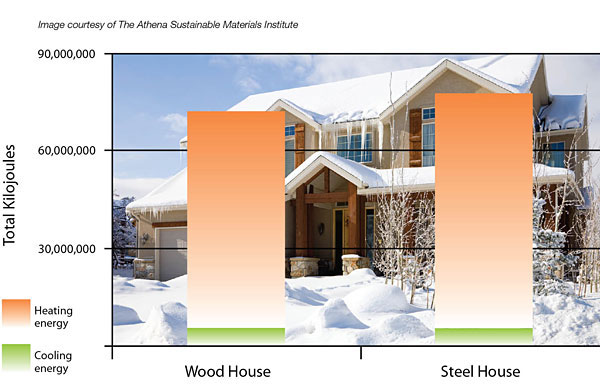Materials In Action
Thermal Properties
The thermal conductivities of building materials have direct bearing on their performance as insulators. A low thermal conductivity indicates that a material is a poor conductor of heat and therefore a good insulator. Any material with open pockets of air will insulate better than a material that is solid. Wood is made up of thousands of tiny open cells that limit its ability to conduct heat. The thermal properties of wood are 400 times better than steel and 10 times better than concrete.11 Their higher conductivity means steel and concrete must overcome lower R-values associated with thermal bridging; consequently they require more insulation to provide the same level of energy efficiency.

In the graph above illustrating energy performance in two similar houses near Chicago, the steel house has significantly more insulation than the wood house and still can’t perform as well. In addition, the steel house has a lot more embodied energy, which is not reflected in the graph.
The two identical houses, unoccupied but with heating and cooling systems operating, were built to standard practice for wood frame and steel frame. Data was measured for one year and also simulated with software in order to normalize and validate results. Both houses have fiberglass insulation between the studs. The steel house has more insulation volume, because its studs are spaced at 24 inches vs. 16 inches for the wood house. In addition, the steel house has a 3/4-inch layer of rigid polystyrene board mounted to the outside of the framing sheathing—standard practice for steel framing—to reduce conduction of heat at the studs. Yet even with these benefits—more fiberglass, the additional layer of polystyrene foam, and fewer thermal bridges because the studs are spaced further apart the steel house still cannot perform as well as the wood house. Steel framing requires a layer of exterior polystyrene foam, which adds cost and embodied environmental effects. If the wood studs were spaced at 24 inches, like the steel (which is sometimes the case), the wood performance would be even better.12
End of Life—A Closer Look at Recycling and Reuse
The U.S. EPA estimates that the U.S. generated more than 160 million tons of building-related construction and demolition (C&D) waste materials in 2003—nearly 53% of which was the result of demolition activities, 38% from renovations, and nine percent from new construction. Only 40% of this waste was estimated to be reused, recycled, or sent to waste-to-energy facilities, leaving 60% going to landfills.13
The concrete and steel industries have made great strides in recycling their materials. Recycled concrete aggregate has found ready markets as road base, asphalt pavement, soil stabilization, pipe bedding and landscape materials; occasionally it is used as aggregate for new concrete. Steel is widely recycled as well. In a year, the American Iron and Steel Institute maintains, the North American steel industry saves the equivalent energy, from recycling alone, to power about 18 million households for a year.
As stated earlier, wood product companies in the U.S. and Canada utilize nearly 99 percent of their manufacturing inputs. The challenge for the future expansion of wood recover is to increase utilization of wood classified as "post-consumer," including municipal solid waste and C&D waste. For some wood products, such as pallets and railway ties, this is already common practice. For others there are barriers. According to the report, Wood Reuse and Recycling in North America, successful and/or recycling of wood products often depends on condition and appearance issues. While "timbers" are either used "as is" or remanufactured into products like flooring, "lumber" and other structural materials can be challenging or costly because of a variety of issues. According to the report, there are opportunities for increased recycling, but barriers to be overcome.
While recycling is considered beneficial, a closer look is warranted. Although reusing concrete aggregate is referred to as recycling, some maintain it’s actually downcycling, as the greatest economic value is in the cement, which can’t be reused. “Design for Deconstruction," a report prepared for California’s Chartwell School partially funded by the EPA, states, “Crushed aggregate even tends to require higher cement mix designs, offsetting some of the benefit and reducing virgin aggregate use." While recycling saves energy, it also expends energy and sometimes in large amounts, particularly in the case of steel. The Chartwell School study says that recycling steel takes 50 percent of the energy required to refine steel from ore.









